ARM A53/A57/T760 investigated - Samsung Galaxy Note 4 Exynos Review
by Andrei Frumusanu & Ryan Smith on February 10, 2015 7:30 AM ESTGPU Performance
In the graphics department we're matching up Qualcomm's Adreno 420 versus the Mali T760MP6. The Adreno is running at 600MHz and is able to benefit from almost double the memory bandwidth at 25.6GB/s versus 13.2GB/s due to the Snapdragon's increased 128-bit memory interface. Let's look at how both compare in our overall benchmarks:

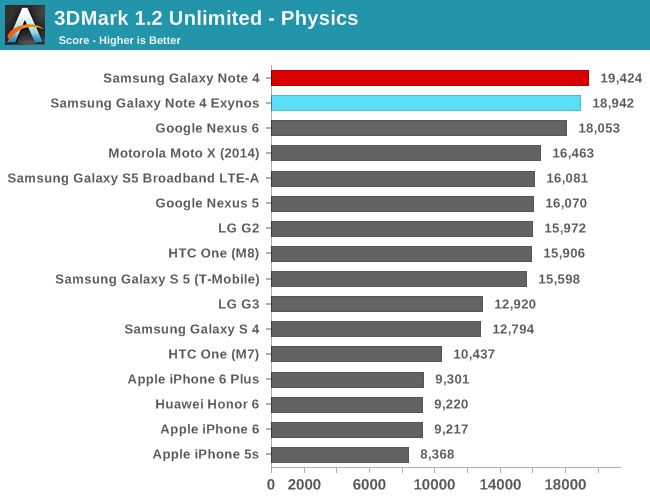
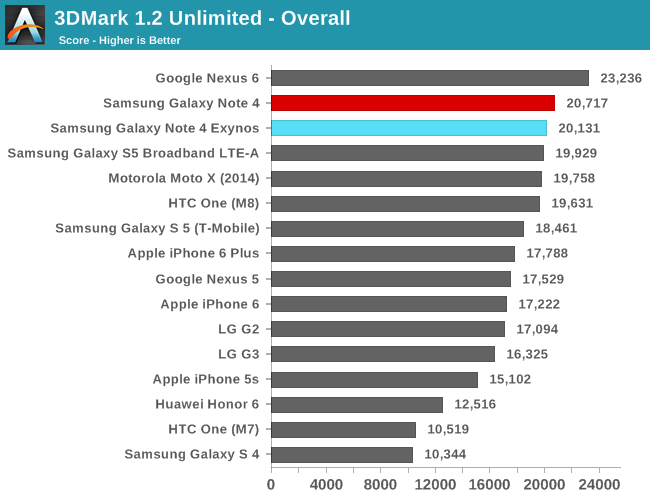
In 3DMark Unlimited the Exynos version comes just short of a few fps behind the Adreno 420. What is also surprising is that the Exynos 5433 performs much better in the physics score than I had anticipated; the same test on Huawei's SoCs limited the thread onto the little cores in the default settings giving mediocre performance results. However, it seems the A53 is performing much better and is able to match Qualcomm's offering now.
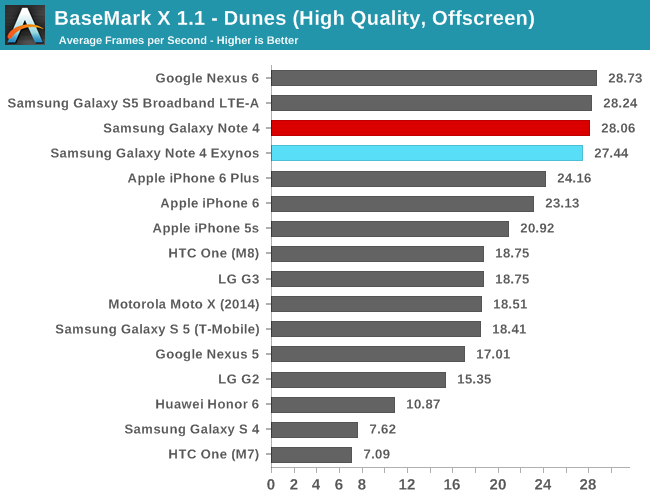
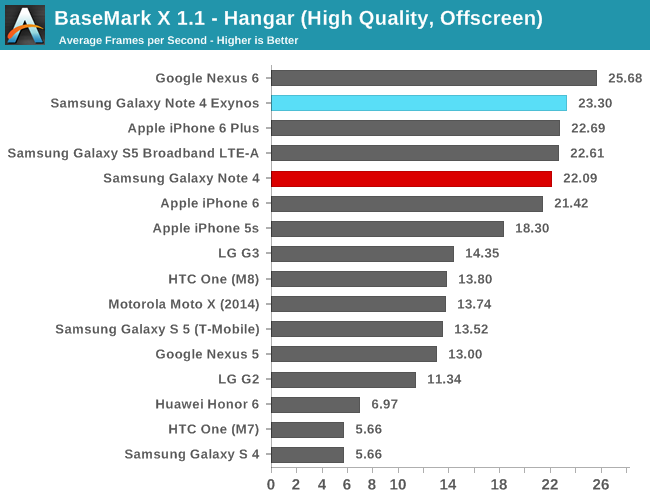
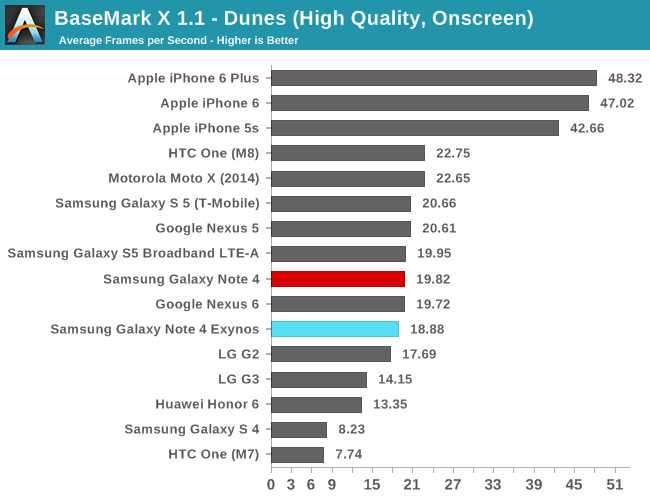

In BaseMark X 1.1, the Exynos is again neck-and-neck with the Snapdragon version. It loses by a slight margin in the Dunes benchmark while winning in the Hangar scenes by a similarly small margin. BaseMark X is again one of the benchmarks that can trigger the 700MHz state of the Mali GPU, offering higher performance at a much higher power draw depending on which scene is currently rendered on both tests.
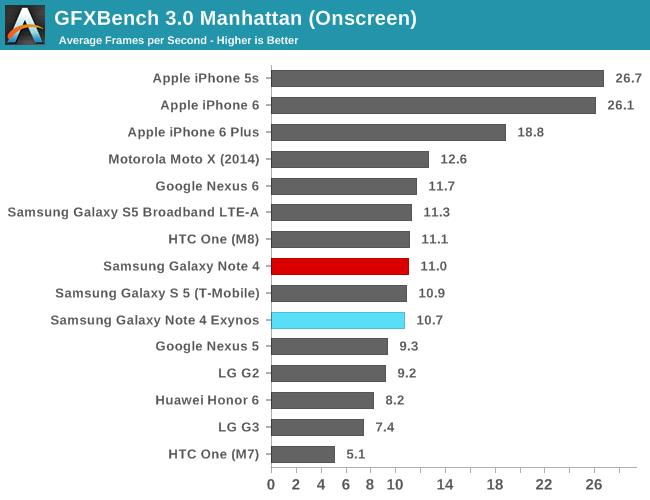
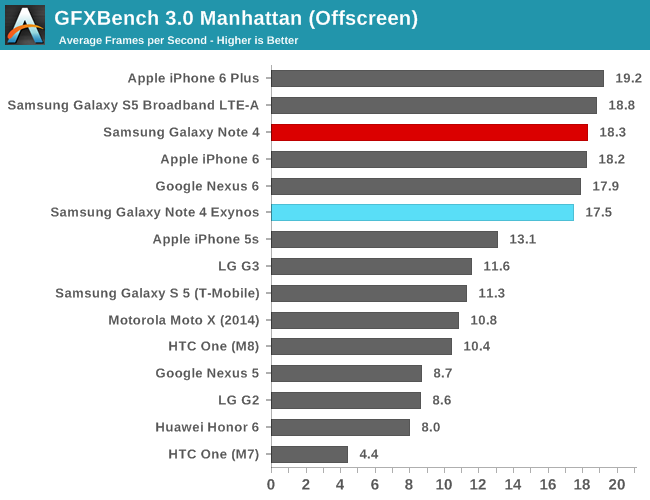
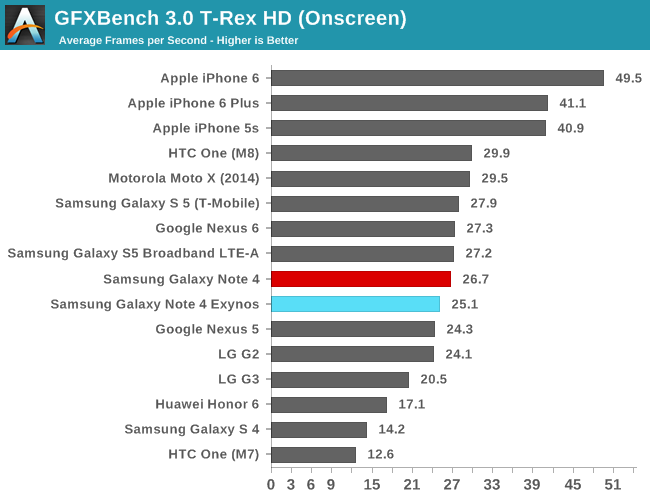
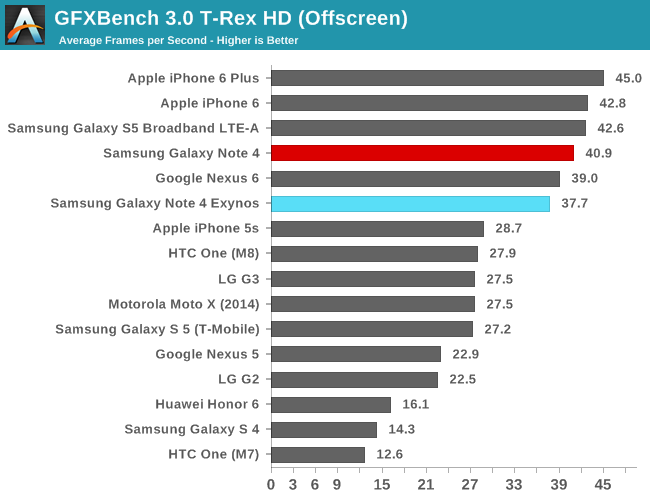
Again we continue to see the same pattern in GFXBench's scenario benchmarks, with the Exynos version lagging a few frames behind the Qualcomm GPU in both Manhattan and T-Rex, in both on-screen and off-screen results.
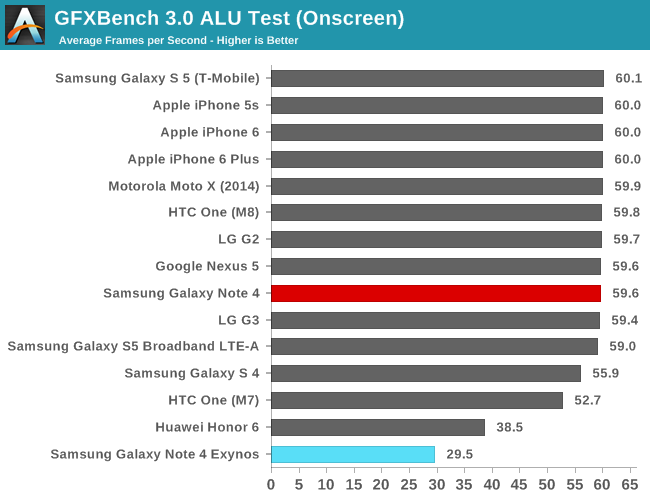

It's on the synthetic tests that we finally see some major deviation between the two architectures. ARM's Mali simply can't seem to keep up with the ALU throughput of Qualcomm's architecture. Both the Adreno 330 and 420 have a clear computational power advantage, exceeding even Imagination's PowerVR GPUs in the iPhones, leaving Mali strictly on the lower end of the performance spectrum.
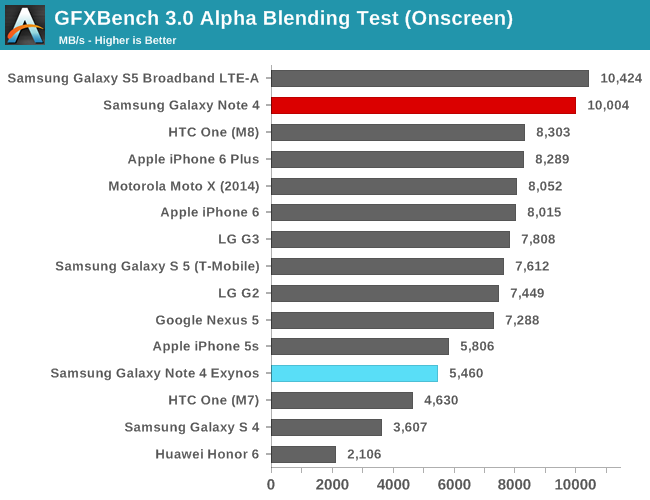
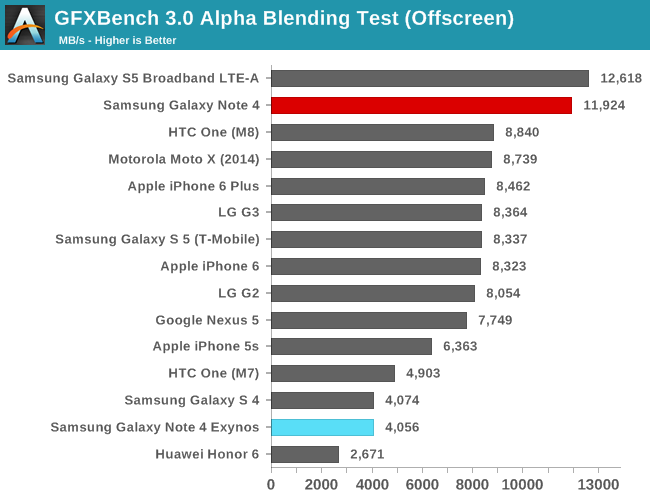
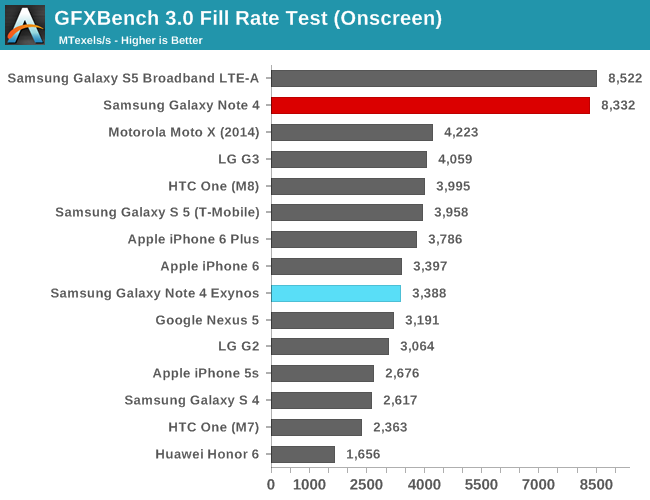
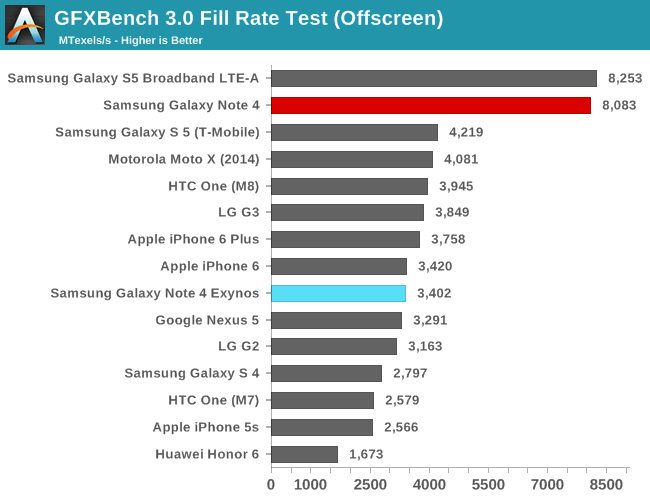
We see a similar situation in the Alpha Blending and Fillrate tests, as the Adreno offers 2-3x the throughput. Utilizing the extra memory bandwidth here seems to be key to the success of the Snapdragon 805's graphics performance.

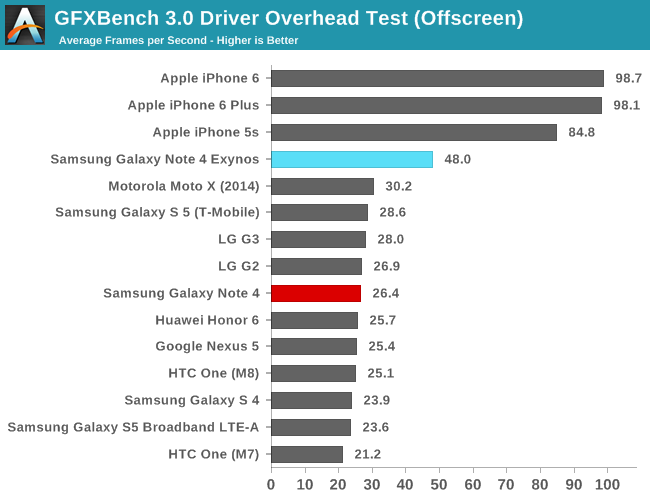
I've already mentioned the Driver Overhead score in the the more in-depth analysis of the T760. It's the first Android device to truly stand out from the rest of the crowd, finally making some progress into trying to catch up with Apple's excellent performance on iOS. Here's hoping more vendors concentrate on improving this metric in future driver updates.
I did some extensive power measurements on the Note 4 Exynos in this review, so naturally we're keen to see how this transforms into our battery benchmarks on the next page.










135 Comments
View All Comments
DarkLeviathan - Saturday, December 19, 2015 - link
They added another core in the new iPad for a totally different reason. Its like having a laptop and a desktop.And there are several reasons why having dual cores in the iPhone is better and having dual cores in the iPad would be a worse idea.
1. The cores in the iPad would get so big and inefficient that it would be pointless to make them bigger. The battery would be wasted. However on the iPhone, the 2 cores are the best size as it is not too small to be slow and too big to be too power hungry.
2. The 3 cores on the iPad is there because they have more space. If they went full Samsun retard style with 4 or 8 cores, you would see 4 or 8 cores with high clock speeds but very low processing power. And therefore inefficient wast of resources and space. Not to mention that most apps only use 1 or 2 cores to run.
zepi - Tuesday, February 10, 2015 - link
Outstanding article, once again.Only thing I'm worried is that writes of such pieces are "Hot Shit" in employment market and I fear our technical writers could yet again disappear to better paying tech-companies...
Andrei Frumusanu - Tuesday, February 10, 2015 - link
I don't plan on going anywhere for the foreseeable future :)Ryan Smith - Tuesday, February 10, 2015 - link
Indeed. Better leg shackles have proven to be an excellent investment this year.rd_nest - Tuesday, February 10, 2015 - link
Wonderful article, loved the detailed analysis done. I wonder if there are any improvements in software stack in 7420 compared to 5433 specially since 7420 will be shipped worldwide.Andrei Frumusanu - Tuesday, February 10, 2015 - link
I'm looking forward to analysing those changes. There should be a considerable amount of change given the new AArch64 kernel platform, but we won't know till it's out.arayoflight - Tuesday, February 10, 2015 - link
I hope to see such an article again in future for the Exynos 7420. Just don't delay that this much.hlovatt - Tuesday, February 10, 2015 - link
I would second zepi's comment "outstanding article", shows why AnandTech is still way ahead of other review sites.TomWomack - Tuesday, February 10, 2015 - link
I'm really impressed by some of the fiddly things you've managed to measure here. What was your source for the die area measurements (Chipworks hasn't done a 5433 tear-down yet), and did you set up the detailed power-monitoring hardware yourself?Andrei Frumusanu - Tuesday, February 10, 2015 - link
The power measurement setup is my own work and we'll hopefully see more of it in the future.